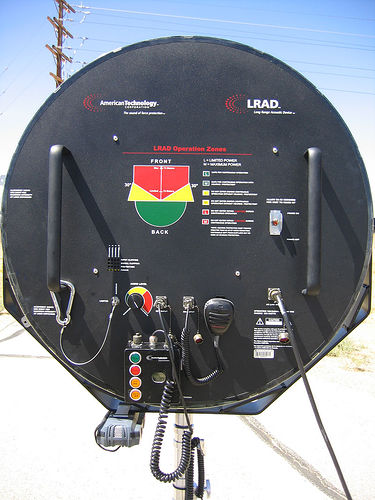Long Range Acoustic Device (LRAD)
By Chiu Longina • Mar 4th, 2008 • Category: DISPOSITIVOSFrom Wikipedia, the free encyclopedia
The long range acoustic device (LRAD) is a crowd-control and hailing device developed by American Technology Corporation.
According to the manufacturer’s specifications, the equipment weighs 45 pounds (20 kg) and can emit sound in a 30° beam (only at high frequency, 2.5kHz) from a device 33 inches (83 cm) in diameter. At maximum volume, it can emit a warning tone that is 146 dBSPL (1000 W/m²) at 1 metre, a level that is capable of permanently damaging hearing, and higher than the normal human threshold of pain (120 – 140 dB). The design range extends to 300 metres maximum usable range. At 300 metres, the warning tone (measured) is less than 90 dB. The warning tone is a high-pitched shrill tone similar to that of a smoke detector.
There appears to be some disagreement over these specifications, as some have reported measurements that differ from the manufacturer’s specifications, and show reduced output with a less directive beam.
It’s instructive to note that any loudspeaker of equal size will generate a beam of the same directivity as LRAD. The parameter “ka”, which is the wave number multiplied by the speaker radius, is often used to characterize sound source directivity. For this source, ka=19 at 2.5kHz, and according to the LRAD data sheet, the beam angle of about 30 degrees total – precisely what is predicted for a regular loudspeaker [1]. Contrary to some beliefs, the device does not use ultrasound, nor is it a phased array; it uses an array of conventional acoustic tweeters, the same as those used in many professional audio applications, all driven together in parallel.
Carl Gruenler, (former) vice president of military and government operations for American Technology Corp. (and who now runs a company making a competing device), says that being within 100 yards (90 m) of the device is extremely painful, but its use should be limited to 300 yards (270 m) to be effectively used. He concedes that the device is powerful enough to cause permanent auditory damage, but that it is only meant to be used for a few seconds at a time.
Countermeasures may include the use of passive hearing protection (earplugs, headsets), which may bring the sound down to ineffective levels. In addition, sound could be reflected from a solid surface, and redirected back to the originator.
Small spherical “point-source” acoustic devices follow the known inverse square law, which predicts the loss of 6db per doubling of distance from the source. Large speakers (or large arrays), such as these mentioned above or those commonly used in concert halls, etc., produce less loss with distance in the nearfield, typically 3-4db per doubling of distance from the source. The larger the speaker, and the higher the frequency, the longer the effective nearfield is (see Beranek). Devices like this generally have nearfields of only a few meters.
Usage
The device was originally intended to be used by American warships to warn incoming vessels approaching without permission, and some reports claim that this is now a “non-lethal weapon”. There is, however, no evidence that the system can be used in this manner, any more than other large loudspeakers.
These devices are currently used at Camp Bucca Iraq and is being tested in regions of Baghdad, Fallujah, along with other regions of Iraq. The LRAD device was also used by police in New York City during protests of the 2004 Republican National Convention and in Georgia against opposition protesters in Tbilisi on November 2007.
The luxury cruise ship “Seabourn Spirit” employed an LRAD while repelling pirates who attacked the vessel with RPGs about 160 km off the coast of Somalia in early November 2005. The effectiveness of this device during the attack is not completely clear, however the pirates did not succeed in boarding the vessel and eventually fled.
INTERESTING LINKS
*How LRAD Works (from http://science.howstuffworks.com)
by Tracy V. Wilson
*Conversation with Woody Norris (LRAD Manufacturer, From Make Magazine)

VIDEOS ABOUT LRAD
.
.
.

Chiu Longina is
Email this author | All posts by Chiu Longina




